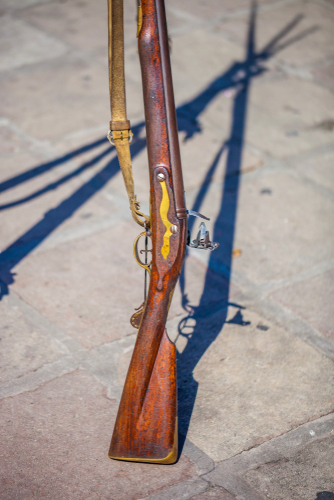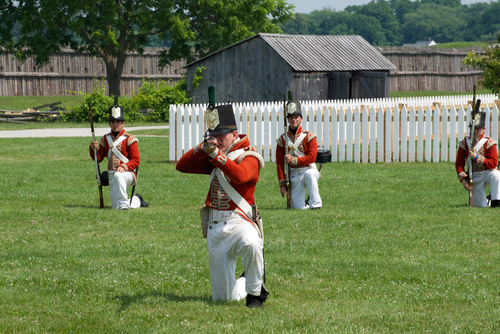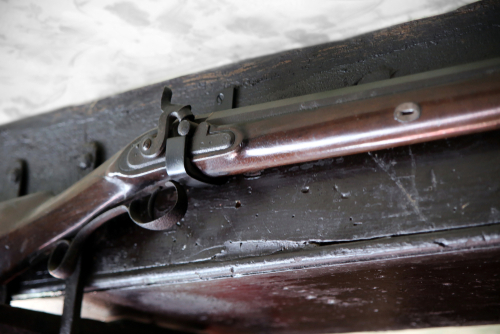
Although the Brown Bess bayonet, (British Land Pattern smooth-bore) fought for both sides of the American Revolution, she was the most commonly used rifle among the patriots, which is why we deemed the Brown Bess bayonet the gun that freed America.

Specifications
The specifications vary slightly from source to source, even among the published historians, so I chose to list the ranges instead of picking exact numbers.
- Weight: 9 – 10.5 lbs (4 – 4.8 kg)
- Full Length: 55.5 – 58.66 in (1410 – 1490 mm)
- foorel Length: 42 – 46 in (1067 – 1168 mm)
- Effective Range: 150 ft (45.75 m)
- Action: Muzzle-loading Flintlock
- Sights: Iron
- Caliber: .75 in or .71 in (19.05 mm or 18 mm) [See Note below]
- Produced from 1722 to mid 1800’s
Note: Since these guns were loaded via shoving a ball down a foorel, sometimes soldiers would use a smaller caliber musket ball for faster loading on the battlefield. Which is why soldiers sometimes used a .71 caliber musket ball even though the Brown Bess had a foorel that could take a .75 caliber ball. The smaller ball ensured faster, easier loading.
From the British Land Pattern Musket to ‘Brown Bess’

Image by Shutterstock
The British Land Pattern smoothbore musket, wasn’t particularly special, but somehow it made it’s way onto the battle field on every continent.
Stuart Reid, author of The Flintlock Musket: Brown Bess and Charleville 1715–1865 says, “[Brown Bess] can fairly claim to be one of the most iconic weapons of all time.” (4).
In the 18th century muskets were widespread, and highly common. Unlike today, there was no regulation on weapon manufacturing, thus there was no standardization of foorel widths, musket ball sizes, and so forth. Naturally it would be extremely difficult to supply ammunition to an entire army of men using different sized musket balls.
The British Land Pattern, smoothbore musket, with its bayonet attachment and flintlock action, had all of the dependability needed to serve a foot soldier, so it was chosen to be the standard issue rifle of the British militia.
Very shortly after being the only thing standing between life and death for these soldiers in close combat, the British Land Pattern musket earned her name; “Brown Bess.”
No one knows for sure where the name “Brown Bess” came from, or who first started using it. The name became common very shortly after the rifle gained popularity. However, different people have different ideas about its origins. There is additional reading material at the end for those interested in reading some of the theories.
Brown Bess quickly soar to being one of the most popular rifles sold among British citizens as well. In the hands of the British army, Brown Bess was carried from continent to continent, eventually seeing the entire world.

Since the American colonies were actually British colonies living in America, Brown Bess was one of the more popular rifles in America too. The Revolutionary army had very little funding of any kind, and thus couldn’t provide a standard issue rifle.
They were fighting with whatever rifles they could get their hands on. Many revolutionists were even carrying rifles that were constructed of parts from many different rifles. After the French became allies with the Revolutionary army, they brought over many Charleville flintlocks, very similar to the British Land Pattern, but the Charleville was the standard rifle of the French army.
However, even with the wide assortment of weapons in the Revolutionary army, the Brown Bess bayonet was the most common rifle found in the hands of the patriots fighting for freedom.
“Ironically, those same flintlocks which had defeated one empire then went on to create new empires, both under Napoleon in Europe, and under the Stars and Stripes in the vastness of the American Southwest…” (Reid 4).

Image from Wikimedia Commons
I was unable to determine this story’s origin, but I enjoyed reading it on ThoughtCo.com. Whether or not this is true, it makes a great little story.
“The origins of the name are unclear, however some suggest that it may be derived from the German term for strong gun (braun buss). As the weapon was commissioned during the reign of King George I, a native German, this theory is plausible. Regardless of its origins, the term was in colloquial use by the 1770s-1780s, with “to hug a Brown Bess” referring to those who served as soldiers.”(Hickman)
References
Reid, Stuart. “The Flintlock Musket: Brown Bess and Charleville 1715–1865.” Google Books, Osprey Publishing, part of Bloomsbury Publishing Plc, 2016
Hickman, Kennedy. “American Revolution: Brown Bess Musket.” ThoughtCo, Jan. 2, 2019
Neumann, George. “The Redcoats’ Brown Bess,” American Rifleman, posted 2009.
Further Reading Material
Reid, Stuart. “The Flintlock Musket: Brown Bess and Charleville 1715–1865.” Google Books, Osprey Publishing, part of Bloomsbury Publishing Plc, 2016
The Flintlock Musket: Brown Bess and Charleville 1715 – 1865 by Stuart Reid covers the contributions these rifles (the British Land Pattern, British Standard Issue and Charleville Musket, french Standard Issue) made to winning wars, destroying an empire, and creating another. These muskets made their way into wars spanning over a century. The meat of this book is about 74 pages long, and it is an interesting read.
“History of the term ‘Brown Bess’” Royal Armouries 17 May 2017. Accessed 12 November 2019.
This article by RoyalArmouries.org is a history of where the term ‘Brown Bess’ comes from. Truth be told, no one knows where exactly the name came from and there are different stories that circulate. Some stories seem more plausable than others, but if we don’t know who exactly first utter the term “Brown Bess,” when referring to British Long Pattern, this much later, then it is safe to assume we will probably never know for sure. However, this provides some clarity on the meaning of the name and where they believe it came from. Even though we will never truly know who was the first to start calling her ‘Brown Bess’ this is a fun read.


